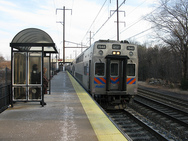Can we build up around MARC stations?

Photo by thisisbossi on Flickr.
It’s not surprising that corporate offices and sprawling suburbs are consuming the green fields between DC’s and Baltimore’s beltways. What is surprising is there’s no real alternative: no urban places are being built at all of the MARC stations in the same corridor.
My wife and I live in Baltimore. Each morning, we splash cold water on our faces before heading to Penn Station in the dark. There, I drop my wife to catch the 5:50 MARC train to Union Station, where she will then transfer to the Metro and arrive at work by 7:30. This is a better choice than driving through morning and evening rush hour in two cities, which she has tried before.
I work in Baltimore, but have meetings in the suburbs between there and DC. By being in the middle, families and businesses can access the employment, cultural, airport, and other benefits of both regions. But the traffic is terrible, and there is pressure to use taxpayer dollars to widen roads or create new ones, like the Intercounty Connector.
The status quo development between Baltimore and DC is comprised of both commercial and residential sprawl, some of which is very close to MARC stations. But the way it’s designed and sited makes it inaccessible to train passengers.
The US Green Building Council (USGBC) and its LEED rating system need to play a role. USGBC should not be giving isolated, land-gobbling sprawl producers green credentials for energy efficiency when these same buildings require inefficient commuting.
By contrast, all seven Penn Line stations, and most of the Camden Line stations between Baltimore and DC lie in a desert of surface parking lots (there’s actually a garage at BWI Airport station). It’s difficult to even get a cup of coffee at most of these outposts. But the train service offered there can deliver a passenger to the center of Washington or Baltimore roughly as fast and as comfortably as the Metro or a car.
Can we encourage transit-oriented development around MARC stations, the way we have around places like Arlington, Rockville, Bethesda, and Silver Spring, which have grown up around Metro stations? Kaid Benfield has covered Arlington’s success in revitalizing neighborhoods without increasing traffic. And Chris Leinberger has described the growth of what he calls “WalkUP” development that is becoming so prevalent in the DC area.
While I advocate for infill development inside the beltways, there’s still demand for development in between. It is time to start urban, mixed-use development along the MARC Penn and Camden lines.
The Maryland Department of Transportation (MDOT) proclaims they are open for business partnerships at MARC stations, and have a transit-oriented development (TOD) underway at Odenton. Private sector developers have made lots of money building urban neighborhoods at Metro stations, particularly in Montgomery and Fairfax counties. There is potential for similar opportunity adjacent to MARC stations.
So why has scattered growth continued between Baltimore and DC while MARC stations remain constellations of barren surface parking? I speculate the issue is the cost of structured parking, which frees up room for urban development. With cheap available greenfields to build lots on, why spend the money?
The frequency of MARC service also affects the prospects for development around stations. Headways on the Penn Line are close to an hour outside of rush hour, while the Camden Line is even less frequent, and offers no trains in the middle of the day or on weekends.
More frequent MARC trains help overcome one advantage the Metro has over Maryland’s commuter lines. Increased service, like weekend service on the Penn Line that started this December, makes TOD more viable because the people who live and work there can rely on it.
There are an increasingly large number of people who travel between Baltimore and Washington that may prefer a hassle-free train ride to a drive in traffic. Especially if there’s a cosmopolitan urban environment where they get on and off the train. There is a premium for this in Bethesda and Arlington, and there could be at MARC stations as well.
To get on a roll at MARC stations, the public sector may have to help build and finance structured parking to open up land adjacent to stations for development. Stu Sirota, principal of TND Planning Group, says there needs to be an overarching vision coupled with marketing. “A real regional planning effort or charrette will show how all these station areas could become cool transit villages (or bigger),” he says, “and what an incredible impact that could have on the Baltimore-Washington corridor.”
Once there are a few hot spots along the Penn and Camden lines, the areas around MARC stations will become coveted real estate. It is time to get started.
